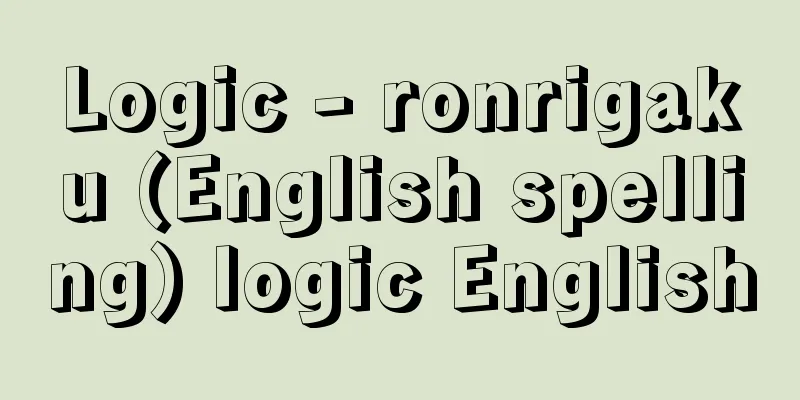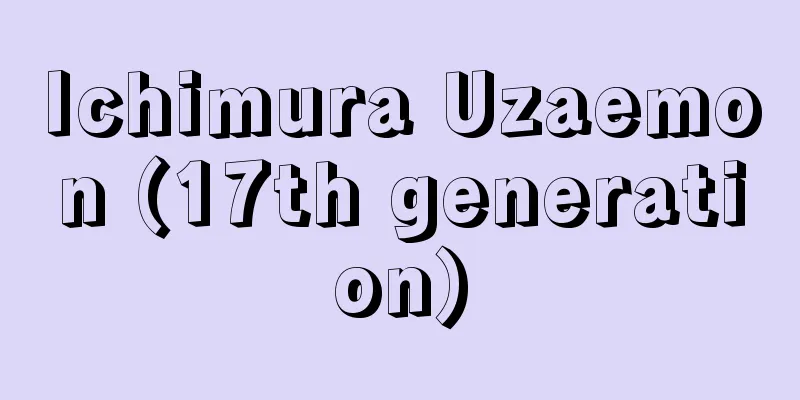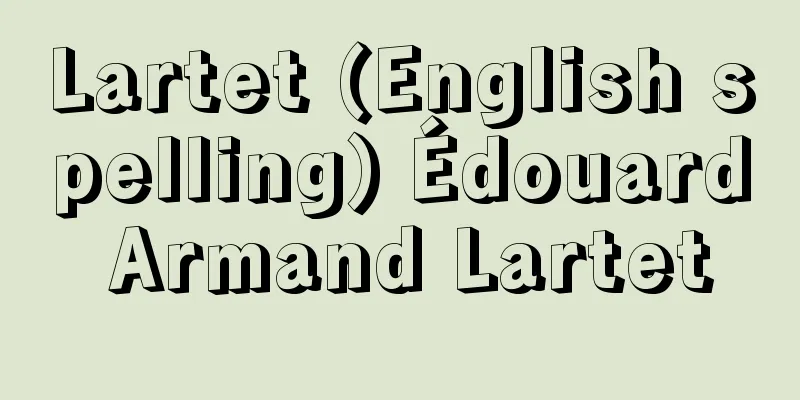Logic - ronrigaku (English spelling) logic English

|
A discipline that studies arguments and the structure of theories as combinations of arguments. In the East, classification of forms of arguments began in India around the 4th century BC, and it is said that detailed research into logic began especially after the rise of Buddhism. This was introduced to Japan and is known as "Inmyo," but there is no direct connection to modern logic. In the West, logic had already been studied at a fairly advanced level in ancient Greece, and Aristotle compiled the results, added his own original ideas, and systematized them, which is known as the oldest document on logic. Aristotle's logic changed shape somewhat through medieval scholastic philosophy, and was established as a curriculum at the beginning of the modern era as traditional logic, and in Japan, traditional logic was the only one taught until about 40 years ago. In the second half of the 19th century, a movement arose (mainly in Europe) to revise logic so that it could analyze mathematical proofs, and this was joined by a trend toward axiomatic reorganization of mathematics, led by set theory, and logic underwent a revolutionary change. Logic after this great change is called modern logic (also known as symbolic logic or mathematical logic). Until recently, in order to emphasize the significance of this change, it was popular to explain the two schools of logic in opposition to each other, but now I think it is more appropriate to focus on the continuity between the two. Modern logic is not a denial of traditional logic, but rather it has been created by absorbing and developing the results of traditional logic that have modern significance, and adding new perspectives and methods. Therefore, in the following, I will first introduce traditional logic, and then explain modern logic as its development. Note that sometimes books define logic as "the study of rules for correct thinking," but this definition is incorrect. Thinking is necessary to obtain arguments, but this thinking does not necessarily follow the patterns of arguments. However, the subject of logic is arguments and theories, not thinking itself. The study of thinking is the task of psychology. [Yoshida Natsuhiko] Traditional logicAn argument is expressed by piling up propositions, and in traditional logic, the proposition that is the basic unit of an argument is called a "judgment." Judgments of the form "S is P" are considered to be the most typical judgments, and are called "categorical judgments." For example, judgments such as "Man is an animal/Socrates is a man" are examples of judgments in which the expression that goes in place of S is called the "head" (main concept), the expression that goes in place of P is called the "faculty" (faculty concept), "is" and expressions with the same meaning are called "copula," and expressions that can be heads or faculties (generally nouns or noun phrases) are called "concepts." "Man" and "animal" are concepts. The whole set of things to which a concept applies is called the extension of this concept. Each individual falls within the extension of "man." Categorical judgments can be seen as judgments that are concerned with the extension of one concept, S, being contained within the extension of another concept, P. All humans are animals, but not all humans are male. To express this distinction, judgments of the form "All S are P" are called "universal positive judgments," and judgments of the form "some S are P" are called "particular positive judgments." Judgments using the negative form, such as "all S are not P" and "some S are not P," are called "universal negative judgments" and "particular negative judgments." Now, among arguments, there are very short ones that show that a conclusion follows directly from a few premises. This type of argument is called an "inference." Traditional logic primarily studied a form of inference consisting of two premises and one conclusion, which was called a "syllogism." A typical example of this is the "categorical syllogism," which looks like this: There is concept S (called the "major concept") that is the head of the conclusion, which is a categorical judgment, concept P (called the "minor concept") that is the object, and concept M, called the "mediating concept." The premises are divided into "major premises" in which S appears in addition to M, and "minor premises" in which P appears in addition to M. For example, "All S are M/All M are P/Therefore all S are P" and "Some S are not M/All P are M/Therefore some S are P" are forms of categorical syllogism, but the former is a form in which a correct argument can be obtained no matter what concepts are substituted for S, P, and M, i.e., a "correct syllogistic form," while the latter is a form in which this is not the case, i.e., an "incorrect syllogistic form." Considering the distinction between universal, particular, affirmative, and negative, there are 256 possible forms of categorical syllogism, and the main task of traditional logic was to extract the correct forms from these. In addition to categorical judgments, there are also disjunctive judgments, which are made up of two judgments A and B and take the form "either A or B," and hypothetical judgments, which take the form "if A, then B." Disjunctive syllogisms and hypothetical syllogisms, which include such judgments, are also possible. For example, they are of the form "either A or B/not B/so A" or "if A, then B/not B/so not A." Dilemmas, which include both types of judgments, are also considered. For example, they are of the form "if A, then C, and if B, then C/either A or B/so C." Traditional logic considered arguments only in forms that could be analyzed into a series of syllogisms. Nevertheless, it was considered sufficient to study arguments in academic fields that flourished until the Middle Ages, such as philosophy, jurisprudence, theology, and biology, which places emphasis on classification and description. However, if one were to rewrite a proposition such as "Points a, b, and c are on a straight line" as a categorical judgment with a, b, or c as the subject, it would be very unnatural. Therefore, in the second half of the 19th century, there was a movement to expand logic to a form in which propositions that assert that a relationship exists between n things are used as basic propositions. In the above example, the three-way relationship "is on a straight line" can be written as "P 3 ," and it can be expressed in the form P 3 (a,b,c). Similarly, "Man is an animal" can be written as P 2 (Man, Animal), with the two-way relationship "The extension of 'Man' is included in the extension of 'Animal'" written as "P 2 ." [Yoshida Natsuhiko] Modern Logic The term "symbolic logic" is used as another name for modern logic because of its extensive use of symbols. First, to create the negation of one proposition A, you put the "negation symbol ¬" before the proposition A and write it as ¬(A). To create a "conjunction" between two propositions A and B, "A with B," you use the "conjunction symbol ∧" and write it as (A) ∧ (B). The usage of the "disjunction symbol ∨" and the "hypothetical symbol ⊃" are as follows: In addition, the opposite of argument, the procedure of starting from an individual proposition and searching for a general proposition that can serve as a premise is called "induction." Induction is used when establishing laws in science. Many scholars have attempted to establish a well-organized system for induction, similar to predicate logic, since ancient times, but so far there have been no successful examples. A certain range of induction has been formulated only in the field of statistics. In any case, the system that would result if such an attempt were successful is called "inductive logic." [Yoshida Natsuhiko] Indian LogicIndian logic began as a means of Mīmānsa (investigation), the hermeneutics of the scriptures concerning ritual regulations. It is usually referred to as "Nyāya" (translated into Chinese as shōri), derived from the verb "to guide," but the word "tarka," which means logical examination, is also sometimes used. Nyāya eventually moved away from the framework of hermeneutics and became independent as one of the academic disciplines of orthodox Brahmanism. For example, in Kautilya's Arthaśāstra, it is listed alongside Vedic scriptures, economics, and political science as academic disciplines that kings should study. Thus, around the time of Christ, it was established as an academic system, and the Nyāya school was born. This school was founded by the sage Gautama, and its main text is the Nyaya-Sutra (the current version was compiled between the 2nd and 4th centuries AD), which is said to have been written by Gautama. According to this text, Nyaya examines 16 subjects: means of knowledge, objects of knowledge, doubt, motivation, examples, established theories, arguments, tests of hypothesis, decisions, debates, controversies, false reasons, sophistry, false accusations, and the conclusion of debates. As can be seen from these subjects, Nyaya was originally a study of argumentation in a broad sense, including techniques for actual debates and arguments, rather than a study of logic. However, according to the preface of the Nyaya-Bhasiya, a commentary on the Nyaya-Sutra by Bhatsyayana (4th century), inference using the five limbs of argument (assertion, reason, illustration, application, conclusion) to present reasoning for others is the "highest Nyaya" because it utilizes all the means of knowledge (direct knowledge, inference, analogy, and language). For example, "(assertion) Sound is impermanent. (reason) Because it is created. (illustration) All created things are impermanent, like a water jar. (application) This is also so. (conclusion) Therefore." In time, the discussion became more detailed about the validity of the reason in this inference, the determination of the pervasive relationship between the two attributes of "createdness" and "impermanence" shown in the illustration, and the relationship between the reason, the pervasive relationship, and the "sound" base. The refinement of this argument is deeply related to the debate over Buddhist logic. Buddhist logic was originally developed in the study of the Abhidharma sect and is usually called Hetu Vidya. This means the study of reason, and is translated into Chinese as "Inmyo" (cause cognition). It was considered one of the five knowledges (gomyo) along with "medicine cognition" and was a required subject for scholars. Inmyo was promoted by Vasubandhu (Vasbandhu), the author of the Abhidharma-sha-ron (Abdhisattva-sastra), but in the 5th century, Dignaga Jinna (Dignaga) completely revamped the theory by meticulously analyzing reason (cause) and proving that three arms of argument are sufficient to develop an inference. This was such a groundbreaking achievement that the knowledge of cause after Jinna was called new inmyo, and the knowledge before him was called ancient inmyo. After Jinna, Buddhism produced such excellent logicians as Dharmakirti, so the Nyaya school was defended by Bhachaspatimishra and Udayana, and Kumarila of the Mimamsa school, also a school of orthodox Brahmanism, also joined the debate, resulting in a three-way debate. In this debate, the Nyaya school gradually moved away from the Nyaya Sutra, its original treatise, and came to base its theory on the analysis of substrates and attributes and the theory of relations of its sister school, the Vaisheshika school. This trend became definitive after Gangesha wrote the great work Tattva-Cintamani (The Wish-granting Jewel of Truth) in the 13th (14th?) century. As a result, after Gangesha, the name of the school came to be called the Naviya (new)/Nyaya school, and scholars devoted themselves to studying Gangesha's works, a tradition that continues to this day. [Keiichi Miyamoto] "The World of Logic and Philosophy" by Natsuhiko Yoshida (1977, Shinchosha) [References] | | | | |Source: Shogakukan Encyclopedia Nipponica About Encyclopedia Nipponica Information | Legend |
|
論証、ならびに論証の組合せとしての理論の構造を研究する学問のこと。東洋では、紀元前4世紀ごろからインドで論証の形式の分類が始まり、とくに仏教がおこってから詳しい論理学の研究が行われるようになったといわれる。これは日本にも伝えられて「因明(いんみょう)」の名で知られているが、現代の論理学とは直接のつながりはない。 西洋では、古代ギリシアですでにかなり進んだ論理学の研究が行われており、その結果をアリストテレスが集大成し、自分の創見を付け加えて体系化したものが、論理学の最古の文献として伝えられている。このアリストテレスの論理学が中世のスコラ哲学を経ていささか形を変え、近世の初めに一つのカリキュラムとして定着したのが、伝統的論理学であり、日本では、40年ほど前までは、もっぱらこの伝統的論理学が教えられていた。19世紀後半になって、数学の論証などを分析できるように論理学を修正しようという動きが(主としてヨーロッパで)おこり、これに、集合論を先頭にする、数学の公理主義的な再編成の潮流が付け加わって、論理学は革命的といえるほどの変化を遂げた。この大変化後の論理学を、現代論理学(別名、記号論理学、また数理論理学)という。 つい先ごろまでは、この変化の意義を強調するために、二つの論理学を対立させて語る解説の仕方がはやっていたが、現在になってみれば、むしろ、両者の連続性に注目したほうが適切であると思う。現代論理学は、伝統的論理学を否定したものというよりは、伝統的論理学の成果のなかで現代的な意味のあるものはこれを吸収発展させたうえで、新しい見地と方法とを付け加えることにより成り立ったものだからである。したがって、以下では、まず伝統的論理学について紹介し、ついで、その発展したものとしての現代論理学について解説することとする。なお、ときどき、論理学のことを「正しい思考をするための規則を研究する学問」と定義してある本を見受けるが、この定義は間違っている。論証を得るためには思考が必要ではあるが、この思考はかならずしも論証のパターンに従って行われるものではない。しかし、論理学が研究対象とするのは、論証や理論であって思考そのものではないのである。思考について研究するのは、心理学の任務である。 [吉田夏彦] 伝統的論理学論証は、命題を積み重ねることによって表現されるが、伝統的論理学では、論証の基本単位になる命題のことを「判断」という。 そうして、「SはPである」という形式の判断をもっとも典型的な判断と考え、これを「定言判断」という。たとえば、「人間は動物である/ソクラテスは人間である」のような判断であり、Sのところにくる表現を「主辞」(主概念)、Pのところにくる表現を「賓辞(ひんじ)」(賓概念)、「である」や、これと同じ意味の表現を「繋辞(けいじ)」といい、主辞や賓辞になりうる表現(だいたい、名詞または名詞句)を「概念」という。「人間」「動物」などは概念である。一つの概念の当てはまる事物の全体を、この概念の外延という。各個人は、「人間」の外延のなかに入るわけである。定言判断は、一つの概念Sの外延が、もう一つの概念Pの外延に包まれることを問題にしている判断とみることができる。すべての人間は動物であるが、すべての人間が男性であるわけではない。この区別を表すために、「すべてのSはPである」という形式の判断を「全称肯定判断」、「SのなかにはPであるものもある」という形式の判断を「特称肯定判断」とよぶ。否定形を使った、「すべてのSはPではない/SのなかにはPではないものもある」の形式がそれぞれ当てはまる判断のことを、「全称否定判断」「特称否定判断」という。 さて、論証のなかには、数個の前提から結論が直接出てくることを示す、きわめて短い論証がある。このような論証を「推論」という。伝統的論理学では、2個の前提と1個の結論とからなる推論の形式を主として研究し、これを「三段論法」とよんだ。なかでも典型的なのは「定言三段論法」であって、これは次のようなものである。定言判断である結論の主辞となる概念S(「大概念」とよぶ)、賓辞となる概念P(「小概念」とよぶ)、および「媒概念」とよぶ概念Mとがあり、前提にはMのほかにSがあらわれる「大前提」と、MのほかにPがあらわれる「小前提」とがある。たとえば、「すべてのSはMである/すべてのMはPである/だからすべてのSはPである」や、「SのなかにはMではないものもある/すべてのPはMである/だからSのなかにはPであるものもある」は、定言三段論法の形式であるが、このうち前者は、S、P、Mにどんな概念を代入しても正しい論証が得られる形式、すなわち「正しい三段論法の形式」であり、後者はそうではない形式、すなわち「正しくない三段論法の形式」である。全称、特称、肯定、否定の区別を考えると256個の定言三段論法の形式が考えられるが、このなかから正しい形式を抜き出すことが、伝統的論理学の主要な任務だった。 判断には、定言判断のほか、二つの判断AとBとからなる「AかBかである」という形式の「選言判断」、「AならばBである」という形式の「仮言判断」もある。このような判断の登場する「選言三段論法」や「仮言三段論法」も考えられる。たとえば、「AかBかである/Bではない/だからAだ」とか、「AならBである/Bではない/だからAではない」とかいった形式のものである。両種の判断がともに登場する「ディレンマ」というものも考えられた。たとえば、「AならCであり、BならCである/AかBかである/だからCである」といった形式のものである。 伝統的論理学では、論証としては、こういった三段論法の積み重ねに分析できる形式のものだけを考えた。それでも、哲学、法学、神学、分類記載に重きを置く生物学のような、中世までに栄えた学問の論証を研究するのには十分だと考えられていたのである。しかし、たとえば、「点a、b、cは、一直線上にある」といった命題を定言判断として、a、b、cのいずれかを主辞とする形に書き直してみようとすると、たいへん不自然である。そこで、19世紀後半になり、一般に、n個のものの間に一つの関係が成り立つことを主張する形の命題を基本命題とする形に、論理学を拡張しようとする動きがおきた。いまの例は、「一直線上にある」という三者関係を「P3」と書いて、P3(a,b,c)という形式であらわせる。また、「人間は動物である」は、「『人間』の外延が『動物』の外延に含まれる」という二者関係を「P2」と書いて、P2(人間,動物)と書くことができる。 [吉田夏彦] 現代論理学「記号論理学」ということばが現代論理学の別名として使われるのは、記号を盛んに使うからである。まず、一つの命題Aからその否定命題をつくるには、その命題Aの前に「否定記号」「¬」を置いて、¬(A)と書く。二つの命題AとBとの「連言」、「AでB」をつくるのには、「連言記号」「∧」を用いて、(A)∧(B)と書く。「選言記号」「∨」や、「仮言記号」「⊃」の使い方は、 また、論証とは逆に、個別命題から出発して、その前提となることができる一般的な命題を探す手続を「帰納」という。科学で法則をたてるときには帰納を行っているわけである。帰納についても述語論理のような整然とした体系をたてようとする企てが、古来、幾人もの学者によって試みられたが、いままでのところ、成功した例はない。わずかに、統計学の分野で、ある範囲の帰納が定式化されている。とにかく、このような企てが成功したら得られるであろうところの体系を「帰納論理学」という。 [吉田夏彦] インド論理学インドの論理学は、祭式規定に関する聖典解釈学であるミーマーンサー(討究)の手段として出発し、普通は、「導く」という動詞から派生した「ニヤーヤ」(漢訳語で正理(しょうり))がそれを表す語として用いられるが、論理的吟味を表す「タルカ」という語が用いられることもある。ニヤーヤは、やがて聖典解釈学の枠から離れていき、正統バラモン主義の学問の一つとして独立の道を歩んだ。たとえば、カウティリヤの『実利論』(『アルタ・シャーストラ』)では、王の学ぶべき学問として、ベーダ聖典学、経済学、政治学と並べられている。こうして、紀元前後には、学問体系としていちおうの確立をみ、ニヤーヤ学派が誕生することとなった。この学派は、聖仙ガウタマを開祖とし、そのガウタマが著したと伝えられる『ニヤーヤ・スートラ』(現形のものは、紀元後2世紀前後から4世紀にかけて編纂(へんさん)されたもの)を所依(しょえ)の論典とした。この論典によれば、ニヤーヤが考察する対象は、知識手段、知識対象、疑惑、動機、実例、定説、論証肢、仮定を用いた吟味、決定、論議、論争、論詰、似非(えせ)理由、詭弁(きべん)、誤った非難、論議の決着の場面、以上の16項目であるとされる。これらの項目からもわかるように、ニヤーヤは、当初、論理学というよりも、実際に論議・論争を行う際のテクニックをも含む、広い意味での論証の学であったといえる。ただ、『ニヤーヤ・スートラ』に対するバーツヤーヤナ(4世紀)の注釈書『ニヤーヤ・バーシヤ』の序文によれば、他人のために推理を開陳する、五つの論証肢(主張、理由、喩例(ゆれい)、適用、結論)を用いた推論には、すべての知識手段(直接知、推理、類比、言語)が駆使されているので、この推論こそが「最高のニヤーヤ」であるとされる。たとえば、「(主張)音声は無常である。(理由)つくられたものであることのゆえに。(喩例)およそつくられたものは無常である。たとえば水甕(みずがめ)のごとし。(適用)これもまたしかり。(結論)ゆえにしかり。」という推論がそれにあたる。やがて議論は、この推論における理由の当・不当、そしてまた、喩例で示される、「つくられたものであること」と「無常であること」との二つの属性の間の遍充関係の確定、その理由と遍充関係と「音声」なる基体との関係について精緻(せいち)に行われるようになった。この議論の精緻化には、仏教論理学との論争が深くかかわっている。仏教論理学は、古くはアビダルマという教学研究のなかで鍛えられ、通常はヘートゥ・ビディヤーと称せられる。これは理由についての学問という意味で、漢訳語では「因明(いんみょう)」とされ、「医方明」などと並ぶ五明(ごみょう)の一つとされ、学僧の必須(ひっす)科目とされた。因明は、『倶舎論(くしゃろん)』の著者世親(せしん)(バスバンドゥ)などによって推進されていったが、5世紀に陳那(じんな)(ディグナーガ)が『プラマーナ・サムッチャヤ』(知識手段集成)などを著すに至って面目を一新し、理由(因)を緻密に分析し、推論を展開するには三つの論証肢だけで十分であることを論証した。あまりにも画期的な業績であったため、陳那以降の因明は新因明、それよりも前の因明は古因明とよばれた。陣那以降、仏教には、ダルマキールティ(法称(ほっしょう))などの優秀な論理学者が輩出したため、ニヤーヤ学派は、バーチャスパティミシュラ、ウダヤナが防戦に努め、また、同じ正統バラモン教の一学派であるミーマーンサー学派のクマーリラもこの論争に加わり、三者三つどもえの論戦の火花を散らした。この論戦にあたって、ニヤーヤ学派は、しだいに本来の所依の論典である『ニヤーヤ・スートラ』から離れ、姉妹学派であるバイシェーシカ学派の基体と属性の分析、関係論を基本とするようになった。13(14?)世紀にガンゲーシャが『タットバ・チンターマニ』(真理の如意宝珠(にょいほうじゅ))という大著を著してからは、この傾向は決定的なものになり、そのため、ガンゲーシャ以降は、学派名もナビヤ(新)・ニヤーヤ派とよばれるようになり、学匠たちはもっぱらガンゲーシャの著作の研究に励むこととなり、現在に至っている。 [宮元啓一] 『吉田夏彦著『論理と哲学の世界』(1977・新潮社)』 [参照項目] | | | | |出典 小学館 日本大百科全書(ニッポニカ)日本大百科全書(ニッポニカ)について 情報 | 凡例 |
<<: Logic Studies - Logische Untersuchungen
Recommend
Lower [village] - Shimo
A village in Imizu County in the north-central par...
vernal conjunctivitis
…It is accompanied by severe itching along with r...
Poisonous hot spring water
...Off the coast of Japan, it is expected that un...
Miracle
…Danish film director. He is the greatest master ...
Homunculus
A manga by Hideo Yamamoto. It depicts the encounte...
Roebling, WA (English spelling) RoeblingWA
…In the late 19th century, the only means of tran...
Dmitriy Sergeevich Merezhkovskiy
Russian poet, writer, and critic. Born into an ar...
Hyperpregnancy - Kajoninshin
…When such animals are bred, implantation of embr...
Tatenawa (vertical long line)
A type of fishing gear also known as a standing lo...
Preaching Yosichiro - Sekkyo Yoshichiro
?-? A Joruri storyteller from the early Edo perio...
Obiita - Obiita
〘noun〙① A belt-shaped board. ② A piece of material...
Law of the Sea
...That is, (1) the maritime order consisting of ...
Anglo-Japanese Alliance
An alliance with military obligations between Jap...
Kitayama River
This river originates near Obamine Pass in Yoshin...
Hino Arinori
1302‐63 (Kengen 1‐Shohei 18/Sadaharu 2) An aristoc...









